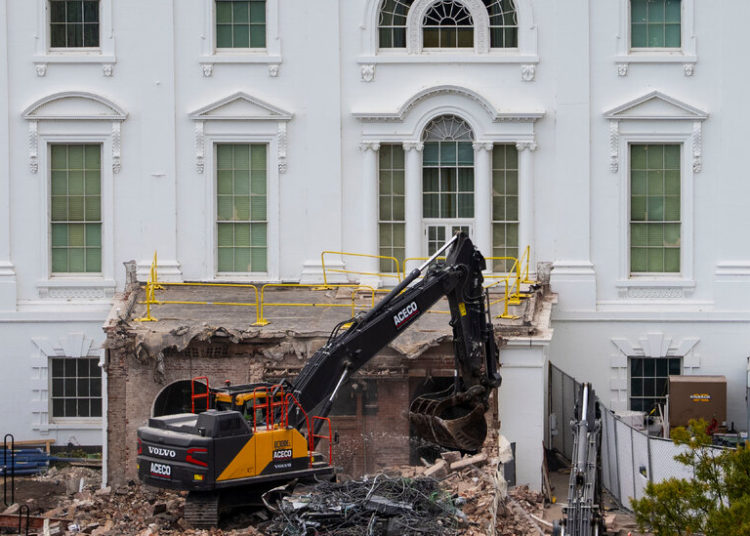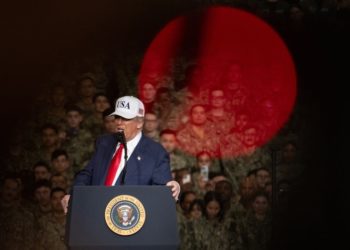A House of Dynamite, Kathryn Bigelow’s new film about nuclear war, premiered on Netflix on Oct. 24. It is a Hollywood production meant to entertain, and it does that well, but it also teaches us four big lessons about nuclear strategy.
The first clear lesson is that nuclear weapons are back. The movie opens with a title card stating that, after the Cold War ended, major powers thought the world would be better off with fewer nuclear weapons but “that era is now over.”
This is correct. During the Cold War, the general public understood the threat of nuclear war, and popular films, like The Day After, dramatized the world-ending danger of atomic weapons. Over the past several decades, however, U.S. foreign policy focused on the wars in Iraq and Afghanistan, and mass media followed suit—just look at Bigelow’s previous films, The Hurt Locker and Zero Dark Thirty.
But in the last few years, nuclear weapons have returned, along with great-power competition. Russian President Vladimir Putin is making nuclear threats to backstop his invasion of Ukraine. North Korea has become the third U.S. adversary with the ability to launch a nuclear attack on the United States. And China is engaging in the world’s most rapid nuclear buildup since the 1960s.
A direct conflict between the United States and any of these countries could result in nuclear exchange, but this reality has not yet sunk in for the average American, which poses a problem. Congress must continue to allocate the necessary funds to modernize the United States’ nuclear deterrent, for example, but this is a more difficult political task without broad-based public support.
By helping to remind the American people that the threat of nuclear war is real and growing, Bigelow also does a favor for U.S. national security.
The second lesson that the film imparts is about how U.S. adversaries are increasingly working together. The plot centers on a single, unattributed, and nuclear-armed intercontinental ballistic missile headed for Chicago. The United States’ early warning system somehow misses the launch. There is speculation that the missile originated from North Korea, but American officials cannot be sure. As the United States moves to DEFCON 1, other nuclear powers, including Russia, mobilize their nuclear forces in response. One of the film’s characters hypothesizes that this is the first step in a combined Chinese, Russian, North Korean, Iranian, and Pakistani assault on the United States.
While Pakistan is not a U.S. adversary, the other countries have been working together to threaten the United States and its allies in what some have referred to as an “axis of aggressors.” This is most obvious in Russia’s war against Ukraine, where North Korean soldiers are fighting alongside the Russians, Iran is sending drones, and China is providing Russia with everything from an economic lifeline to super heavy-duty trucks.
It is possible that the United States could find itself in simultaneous conflicts with multiple nuclear-armed great powers. If the war in Ukraine escalates into a broader NATO-Russia war, will Chinese President Xi Jinping simply eat popcorn and watch, or, with U.S. forces tied down in Europe, will he see his chance to take Taiwan? And vice-versa: A U.S.-China war could provide the opportunity for Putin to move on NATO to achieve his long-standing ambition to restore the Russian empire.
Moreover, as I have written in these pages, it is unlikely that a U.S.-China war over Taiwan will stay contained to the Taiwan Strait. It will become a region-wide conflict, engulf the Korean Peninsula, and become a simultaneous war with both China and North Korea.
Any of these conflicts would carry a risk of nuclear war. Unlike in the film’s script, a nuclear launch is less likely to start as a bolt-from-the-blue and more likely as escalation from a conventional war among nuclear powers.
In short, A House of Dynamite reflects the U.S. national security community’s fears that, unlike the Cold War, Washington no longer faces just a single nuclear adversary. The United States must design a nuclear strategy and posture to deter multiple nuclear rivals simultaneously.
Third, the plot centers on the importance of missile defenses to protect the United States from nuclear attack. Washington has one chance to forestall the death of 10 million Chicagoans and worse to come. It attempts to intercept the incoming missile with two ground based interceptor missiles (GBIs), but one malfunctions and the other misses its target.
One could infer from this scene that missile defenses are a fool’s errand. The film’s deputy national security advisor likens missile defenses to hitting a bullet with a bullet. When told that the GBIs have a success rate of 61 percent, the film’s defense secretary exclaims, “So it’s a fucking coin toss? This is what $50 billion buys us?”
The lesson I draw is that missile defenses are potentially important and lifesaving, but that Washington needs a more robust system. After all, if a nuclear-armed missile were hurtling toward my city, I would take a “coin toss” over certain annihilation. If the missile defenses had worked, catastrophe would have been averted, and the film would have ended after 15 minutes.
Washington does need a better system, however, and this is why the Trump administration is rightly making the “Golden Dome” a major priority. With a space-based sensor layer, the United States likely would have been able to detect the launch. And with space-based kinetic and directed-energy interceptors, it would have been in a better position to stop the nuclear attack.
Even with the current system, Washington’s chances of taking out a single missile are probably better than the film portrays. The United States currently has 44 interceptors deployed at bases in Alaska and California. In the film, it only launched two because officials said they needed to hold the others in case there were follow-up attacks. In reality, U.S. leaders would have done everything in their power to stop a single nuclear weapon from hitting the country, not hold back capability for future nuclear attacks that might never come.
The fourth and final lesson is about limited nuclear war. This is my biggest gripe with the film, and here is where you should stop reading if you’re planning to see it. The film ends with the president’s advisors pressing him for his nuclear response orders. There is an assumption that the president must decide on how to retaliate before the enemy missile hits Chicago.
There is also an assumption that the U.S. response will be big and lead to large-scale enemy retaliation and the end of the world as we know it. The deputy national security advisor tells the president that his options are “suicide or surrender,” and the suicide option seems almost inevitable. A staffer working in the White House Situation Room tearfully says goodbye to her husband and daughter over the phone as if it will be their last earthly communication.
But both assumptions are problematic. There is no reason that the president must order an immediate nuclear retaliation with a single nuclear missile heading to Chicago. The president would have the option to launch under attack, but they would also have the option to ride out the attack, take time to gather more evidence, consider options, and carefully respond days or even weeks later. In the scenario depicted in the film, in which the characters are not even sure about the missile’s origin, any U.S. president would almost certainly take some time to study their options before launching a major nuclear war against an unknown adversary.
Moreover, the options are not “suicide or surrender.” Since the Kennedy administration, the United States has had limited nuclear options. If an enemy launches a nuclear weapon or two at the continental United States, Washington can launch one or two back. It is not all or nothing. The logic of limited nuclear war is to show the adversary that Washington is resolved, but they still have a lot left to lose. By seeking an off-ramp after an initial limited exchange, both sides can avoid further catastrophe.
Since the end of the Cold War, however, Washington has dismantled many of its lower-yield nuclear weapons, ideally suited for a limited response. As a bipartisan congressional commission (on which I served) recently recommended, the United States must develop and deploy additional nonstrategic nuclear weapons to deter these kinds of limited attacks.
When Americans stream A House of Dynamite, I hope they think about the dangerous nuclear environment the world is entering and the critical role they play in supporting U.S. policies that will make the country and the world safer.
The post The Lessons of ‘A House of Dynamite’ appeared first on Foreign Policy.




